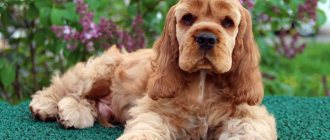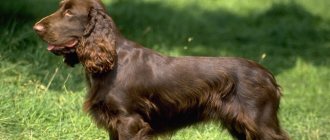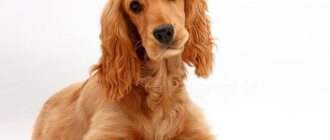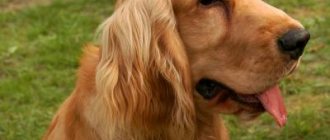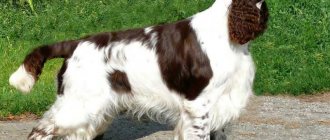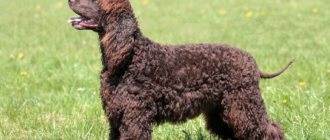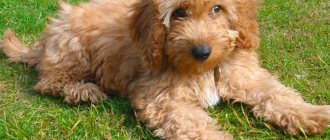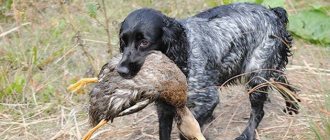History of the breed
If you look at a cocker spaniel, you will immediately notice the distinctive feature of this breed - long ears. From this we can conclude that the ancestors had a similar feature, but this is erroneous. Local representatives of canids had small ears; it remains interesting that these dogs existed back in the Bronze Age.
The original purpose of cocker spaniels was to perform a hunting function; I consider this breed to be the ancestor of all currently existing specialized breeds.
As a result of selection, spaniels acquired long ears, but it is not possible to definitively answer why dogs have such ears. Some say that this is a tribute to the fashion of the times when the breed was being formed, others adhere to the theory that thanks to the long ears, the inside of the ear is protected from water getting there, while a representative of this breed swims.
Scientists call spaniels “ashy”, which is due to the fact that the remains of good quality dogs were found in ash deposits. It is quite possible that today's pets served as sacrificial animals that were burned at the stake.
The qualities of hunters were passed on from generation to generation in dogs, and along the way they were improved by humans. Representatives with the same appearance were selected for breeding. This is how the breed known as the Cocker Spaniel was formed. At that time, no one even tried to divide it into subgroups (American, Russian, English, etc.)
Almost all researchers believe that the dog was bred in Spain, and among the ancestors were local long-haired hunting representatives.
Opponents of this theory say that it is impossible to use the external similarity of the two words “Spain” and “spaniel” in order to confidently state the origin of the breed. In this case, the ancestors could have been British dogs of medium size, long hair and an excellent sense of smell.
Nutrition
Every owner thinks about their pet’s diet. Draws information from books or the Internet, trying to follow all the rules. Especially with a purebred dog that cannot digest anything, you need to understand nutrition. The diet should be complete, filled with vitamins.
English cocker spaniel gives paw
Proper diet for a spaniel is very important. This breed is prone to overeating and obesity. You should not spoil him with food from the master's table. Sometimes it is simply impossible to resist the pleading look of a cocker. Kind eyes look and beg for a tasty treat. The animal's good appetite leads to distension of the stomach. As with any dog, enormous weight is contraindicated for a cocker.
Drinking in your diet is very important. A bowl of clean water should always be in place. English Cocker Spaniel puppies can drink milk . It is contraindicated for adults. Fermented milk products can be an addition to food. Watch the portion your dog eats. For a puppy, 4 tablespoons per feeding is enough. The dog grows and the amount of food increases.
- A puppy up to 2 months eats 6 times, but in small portions;
- From 4 months, doses are reduced by 2 times;
- From 4 to 6 months, the puppy eats 3-4 times a day;
- Up to 1 year, the portion is increased, and the doses are divided into 2-3 times;
- After a year, cockers are fed 1-2 times a day.
When getting a dog, the owner must choose feeding hours that are convenient for himself and the pet. Since everyone's workload is different, the working day can last a long time. The animal should not starve.
The diet must be varied so that the dog receives the necessary beneficial components for its body. The main products are: meat, cottage cheese, fish, vegetables and porridge.
Vegetables should be served stewed. It is better to take meat that is not fatty. For example, chicken, beef, and turkey work well. Sometimes you can add eggs to your food, but not more than one per week. There are also vitamin complexes; they must be given to the dog once every half-hour to maintain healthy coat and teeth.
Description of the breed, character of the spaniel
Cocker spaniels are great for families with small children. Strangers do not arouse any interest in representatives of this breed, unless the four-legged animals themselves begin to become curious. Dogs find an approach to existing pets, and it doesn’t matter who is already in the house. A showdown or a fight is a very rare occurrence for a spaniel. As for feeding and care, the owner will not have much difficulty.
Worth knowing! In this breed, females are very dominant compared to males. Therefore, they will need to pay more attention.
Despite the fact that spaniels get along well with children, adults should pay attention when the child is interacting with the dog. A conflict may arise at the moment when the pet and the baby are trying to figure out the identity of this or that toy, and this is where the representative of the breed begins to show strength of character.
If the dog is used for its intended purpose (hunting), then here they show their best qualities and are tireless helpers for humans. Spaniels are very playful animals and work well in a team or individually. On average, they can live about 12 years, but a lot depends on diet and care.
There is no point in choosing a spaniel for the position of protector; these dogs are very friendly and sociable with strangers, and therefore, if they see a stranger, they will not make a fuss, much less try to stop him.
Some representatives of the breed become very attached to their owner, which ends in the animal’s complete lack of independence.
Despite its hunting instincts, when walking, a spaniel rarely pays attention to the various city birds that it meets on its way. Dogs express their loyalty to members of the human race by wagging their tail.
Spaniels are distinguished by their intelligence and intelligence, which allows them to easily remember various commands during the training process. The four-legged pet especially loves games in which you need to find a hidden toy or bring it. As for punishments, spaniels are very sensitive, and therefore shouting at them or hitting them is not recommended.
English cocker spaniel and man
This is a tireless hunter, a wonderful friend and companion. He is devoted to his owner and is ready to follow him to the ends of the earth. Thanks to its compact size and easy care, an Englishman feels good both in a country house and in a city apartment, provided there are active walks, activities, and communication with the owner. It is not advisable for older people and those who do not like active recreation to have a spaniel.
The spaniel cannot act as a full-fledged guard, but it makes a good “bell” - this breed is prone to loud barking with or without reason, and will warn you of the approach of a suspicious stranger.
This is a tireless friend for children . He is patient with little ones and will not bite a child. The main thing is to ensure that children do not torture the dog. The cocker is “for anything except a hunger strike” and happily joins in outdoor games with children - catching up, fetching the ball, hide and seek.
He is patient with other pets, but can also get into conflict with a cat or other dog.
Breed standard
Each variety of spaniel has its own developed standards, which will be discussed later. Next, general features characteristic of representatives of this breed will be presented.
The body is square, and the muzzle is triangular in shape. The head has smooth outlines, the nose is wide.
The main color of the eyes is brown, different shades are allowed. The eyes themselves are large, there is no bulge. The ears hang down and are located at eye level, they have the shape of flaps, while they are completely covered with fur. Dogs have a scissor bite.
The animals have a well-developed, narrow sternum and a medium-length cervical region. The front legs are shorter than the hind legs, but at the same time very powerful, which has a positive effect on the performance of the spaniel. The hind legs are strong, thanks to the knee joints with good flexion amplitude, dogs can move quickly. The paws end in soft pads. Spaniels have a movable tail, which is docked in most cases.
The coat is silky, long, straight, and has no coarse hairs. Dogs' coats can vary from spotted to solid. In the latter case, the presence of white spots is considered a flaw.
Animals weigh from 12 to 14 kg.
History of the origin of the species
The origins of the English Cocker Spaniel date back to the Bronze Age. The ancestors are considered to be ancient hunting dogs called “ashy”. Historians and archaeologists have found the remains of dogs in the ash. Ancient people presented them as sacrifices to the gods.
Ash or ash dogs had all the qualities of a hunter; they had developed body muscles and long limbs.
Centuries-old attempts to consolidate the hunting skills characteristic of one species led to the appearance of spaniels. One version connects the name of the breed with Spain. It is believed that the ancestors of modern spaniels were Spanish hunting dogs.
The British have a separate version of the origin of the breed. The word "spaniel" is equated to the English word "span spaniel" , meaning "one who can jump high" . Dogs on the hunt suddenly jump out of the thick grass, catching their prey by surprise.
The word "cocker" is the name of the woodcock bird. English cocker spaniels were bred to hunt birds, including woodcock, which is native to the British Isles.
The popularity of breeding hunting breeds among dog breeders arose in the 19th century. Official recognition and registration by English dog handlers occurred in 1893. The breed was recognized by the world community of dog breeders 9 years later, in 1902. But only in 1974 an international standard was approved and the breed was recognized by the Federation of Cynologists.
Russian dog breeders became interested in the British in the 70s of the last century. Dogs were imported from European countries. Dogs have become regular participants at Russian exhibitions since the 80s.
Types of Spaniels
As mentioned above, there are a large number of varieties of this breed.
English cocker spaniel
The breed was bred in Great Britain, the breeders pursued the goal of obtaining the ideal hunting dog. Height at the withers is from 25 to 36 cm, average weight is from 6 to 10 kg. Representatives of the breed are distinguished by a harmonious physique and well-developed muscles. The head is large and regular in shape, the eyes are dark in color, the ears are low set and the coat is long and can be wavy.
The limbs are wide and the paws are webbed, which gives the dogs excellent swimming ability. The suits can be very diverse. Among the most popular are:
- black and blue;
- redhead;
- black;
- black and fawn.
This breed is suitable for apartment living, but the pet requires long walks and physical activity. If there are children in the house, then the spaniel will get along well with them. If the potential owner has no experience in dog breeding, then it is worth considering that spaniels are very energetic, and their coat will need to be carefully looked after.
On a note! For spaniels, loneliness is unbearable, it leads to mental disorders, and deviant behavior (deviation from the norm) also develops. Life expectancy is from 12 to 15 years.
American Cocker Spaniels
It is not so easy to say exactly when this breed was bred. There is an assumption that this happened at the end of the 19th century in the United States. Modern Americans have a height at the withers of about 39 cm, and a weight of up to 15 kg.
The dogs are distinguished by their strong build and rounded, well-proportioned head. The animals have a wide muzzle, a deep sternum and a stately back. The ears are wide apart and long.
The coat can be smooth or wavy; it is shorter on the head, in contrast to the body. The most common suits are:
- black;
- black and tan;
- red with spots;
- fawn.
The American Cocker is an excellent companion that can become a true member of the family.
The owner will have to remember that the dog needs long walks, because it has an active character. For representatives of this breed, communication and attention from the owner are very important; they absolutely cannot stand loneliness. They are distinguished by their loyalty to children and pets, if any. The training process is very easy, thanks to the dog’s intelligence.
Irish merman
This type of spaniel is large and heavy. Ireland is considered to be the place of breeding, but there is no exact data on how the breed was formed today.
Dogs reach a height at the withers of 50 to 60 cm, and gain weight of 20 - 30 kg. The Irish have a proportional build, rather dense and stocky. The head is medium in size, ending in an elongated muzzle and drooping ears. Some mermen have a forelock and beard. It is worth noting that this spaniel is the tallest of its kind.
The coat is soft and has curls. The standard suit is brown with a red tint. This breed is recommended for keeping only by experienced breeders, because Mermen are active, and they need regular physical activity, as well as an experienced trainer.
The breed was bred for hunting both on land and in water, which means the pets will need to spend a lot of time walking and swimming in water. The Irish have proven themselves to be excellent pets with a quiet and calm character. Thanks to their devotion, they become attached to the owner, but all these qualities are developed exclusively by proper upbringing. Merman vices include aggressive behavior and cowardice.
Basic rules of care
The basic rules for caring for a black cocker include:
- Grooming . This may include brushing and bathing. The spaniel's coat is long, silky, and often tangled, so the dog is brushed 4-3 times a week using various brushes and combs for dogs. As for bathing, this procedure is carried out at least once a month, the reason is the same. To do this, it is recommended to use a special shampoo for dogs with long hair.
- A haircut. The cocker is trimmed once every 2 months, paying special attention to the paws and the space between the toes.
- Caring for the spaniel's ears must be especially careful, since the dog has floppy ears covered with long hair. This structure contributes to the rapid contamination of the ears and the development of inflammatory diseases and infections. Therefore, the spaniel's ears are examined daily, and once a week they are cleaned with a cotton pad and an antiseptic solution.
- The dog's nails are trimmed as they grow (once every 2-3 weeks), using a special nail clipper. Nails can also be trimmed at a grooming salon.
- Eye care . The pet's eyes are examined daily for discharge and washed once a week with weak tea leaves or chamomile decoction.
- Walks and exercise . The dog needs daily walks and exercise. You need to walk your dog at least 3 times a day, for 1.5 - 3 hours, to satisfy the need for activity.
- Balanced diet . The dog can be fed both dry food and natural food. In the second case, the dog must be given vitamins and supplements with microelements.
NOTE!
Cocker spaniels do not tolerate loneliness well, so before getting such a dog, you should soberly assess your capabilities. Staying alone for a long time can lead to a dog's mental disorder.
Pros and cons of the breed
Any breed has its positive and negative sides, the same applies to spaniels.
Advantages and disadvantages
| Positive traits | Negative qualities |
| Small sizes | Gluttony |
| Activity | Improper socialization leads to aggressive behavior and cowardice |
| Endurance | Having ear problems |
| Good travel tolerance | The appearance of mental problems when being alone for a long time |
| Ease of training |
Beagle dog breed with photos and descriptions
Distinctive features
The main parameters characterizing the English Cocker Spaniel:
- The head is regular in shape, with a clear outline.
- The ears are drop-shaped, long, thin, located in line with the eyes.
- The eyes are large, round, and dark shades of brown. Light eye color (light brown) is allowed in dogs with chocolate-colored fur.
- The nose is black with large nostrils (for a good hunter's instincts).
- The bite is scissor-shaped, the incisors develop strictly vertically.
- The back is physically well developed.
- The forelimbs are straight and small in size.
- The hind limbs differ significantly from the front limbs in their developed muscular system. Large hips, designed for fast running, characterize the dog's purpose as a hunter.
- Tail with thick hair. In an excited and joyful state, the height of the tail does not reach the height of the back.
- The coat is of medium abundance, without curls. Long hair is present on the legs and along the perimeter of the lower body.
Possible colors according to standard
Maintenance, care
Feeding
Spaniels have an excellent appetite, and if you do not follow a certain diet, it is very easy for your dog to develop various diseases, ranging from stomach problems to overweight.
Feeding can be either natural or using factory feed. If you choose the first option, you can use the following products:
- chicken meat;
- horse meat;
- beef;
- stomachs;
- hearts;
- liver;
- lungs.
Additionally, vegetables and boiled fish are provided. Among vegetables, preference is given to:
- cabbage;
- turnip;
- pumpkin
You can diversify your diet with millet or oatmeal porridge.
When choosing industrial dry food, you need to pay attention to the fact that it contains the microelements and vitamins necessary for dogs. Today, in specialized stores you can purchase food for both puppies and older dogs in different physiological states. To make the right choice, you can contact your veterinarian, who will give advice on what is best for your pet.
Upbringing
There are three ways to train dogs:
- encourage;
- punish;
- reward and punish.
Each option has its own advantages and disadvantages. Dog handlers consider the latter method to be the most effective.
As for encouragement, it is used if the pet behaves as a person needs and fulfills all his requirements. This approach greatly increases the likelihood that the dog will do everything to gain the owner's approval.
Favorite treats or praise are used for encouragement. Using this method it is easy to shape the dog's behavior. They praise the pet using quiet, affectionate intonations, pet it and give it a piece of something tasty.
If we talk about punishments for spaniels, then a reprimand is enough for them. With a stern and sharp shout, the dog understands that the owner is not satisfied with its behavior. After the pet traces the connection between what he did and the owner’s dissatisfaction, then he will try to avoid actions that lead to condemnation.
Punishment does not always give a positive result; if there are no changes in behavior, then the owner needs to monitor the pet; it is quite possible that the punishment was given for the wrong mistake.
Despite the fact that spaniels are smart, they do not remember commands the first time. It takes a long time to train to get the desired result. It is important for the owner not to lose patience even in cases where the pet exhibits behavior that is far from the owner’s expectations.
Dachshund dog breed with photo and description
Care and maintenance of English spaniels
As we have already said, English Cockers are a hunting breed. Consequently, spaniels will have to walk outside a lot. Based on this, the owner must lead an active lifestyle in order to fit his pet. It would be ideal if you walk your puppy for 2-3 hours every day.
Caring for a spaniel is not very difficult. The main thing is timely bathing and combing the coat. It is advisable to do this once a week. It is also very important to occasionally brush your pet’s teeth, take care of his ears and trim his nails.
Spaniels love to eat delicious food and cannot stop in time, so they often overeat. Therefore, the owner must make sure not to overfeed his pet and ensure that he is active every day. Otherwise, you may end up with a lazy, obese and passive dog.
Puppies
Choosing a puppy
If the choice is made in favor of a dog that will be used for hunting, then the potential owner should pay attention not only to the pedigree of the female and male from whom the puppy is supposed to be adopted, but also to their field diplomas. Here the demonstration of obedience and their hunting qualities are recorded.
Efficient parents will produce offspring with similar qualities. The sale of young animals begins 45 days after their birth. During this period, certification (monitoring of development), stamping and issuance of documents take place.
When choosing a puppy, you need to evaluate its physical condition. At the same time, the number of babies in the litter should not affect this quality. For example, where there are 9 puppies, all may differ in fatness, good development and health. Some owners, even with only a few babies in the litter, have puppies that are underdeveloped, have problems with their limbs, and much more. This is where poor care for the bitch takes its toll, and therefore the potential owner is advised to take a closer look at what conditions the breeder has created for his dogs.
A healthy puppy should actively eat, run, play, and show curiosity; if there is lethargy in behavior, it is recommended to wait before purchasing a spaniel.
Price
You can see the cost of Cocker Spaniel puppies of various varieties in the following table.
Price category
| Name | What is the price |
| English cocker spaniel | 11000 — 22800 |
| Cavalier King Charles | 32500 — 140000 |
| English springer | 45000 — 65000 |
| King Charles | 22700 — 97500 |
| American Cocker Spaniel | 4500 — 52000 |
| Papillon | 32500 – 78000 |
| Welsh Springer | 78000 — 91000 |
| Clumber | 58500 — 65000 |
| Field | 32500 — 39000 |
| Irish merman | 45500 — 84500 |
| Kooikerhondje | 39000 — 65000 |
| American merman | 52000 — 65000 |
| Sussex | 32500 — 45500 |
| German Wachtenhuld | 16300 |
Life expectancy and diseases
The lifespan of English Cocker Spaniels is 12-15 years.
Main diseases:
- Glaucoma.
- Cataract.
- Deafness.
- Epilepsy.
- Cherry eye syndrome.
- Inversion and inversion of the eyelid.
- Allergy.
- Hepatitis.
- Otitis.
- Melanoma.
- Hydrocephalus.
- Retinal degeneration.
- Hip dysplasia.
IMPORTANT!
With good care, cockers remain active and cheerful into old age.
Features of character and behavior
The English Cocker Spaniel is a cheerful, playful, good-natured dog. They adapt well to a large family and get along well with single people. However, only one person will be considered the real master and obey unquestioningly. The nature of a getter, strong muscles, and a strong sense of smell of a dog of this breed will also appeal to lovers of hunting and an active lifestyle.
Advantages
The advantages of the English Cocker Spaniel are:
- Beauty . The stately and impressive Briton will not go unnoticed while walking around the park.
- Intelligence – the dog understands human language well, which makes it easy to train.
- Developed intelligence and hunting disposition allows the spaniel to independently make important decisions in the shortest possible time.
- Friendly attitude towards children . Active games in the fresh air attract the dog; the spaniel will happily chase and frolic with the children. Parental vigilance still does not hurt, especially if the child is under 7 years old.
Flaws
The disadvantages include negative points:
- Pets are strongly attached to their owner , sometimes allowing them to show feelings of ownership and jealousy.
- Stubbornness is a characteristic trait of the breed. A calm explanation of the rules and training from an early age will help the owner raise an obedient pet.
- Some individuals are prone to long barking. Observation and consultation with a veterinarian will help the breeder rule out mental abnormalities.
Mating
- Before mating, the breeder and the pet are required to visit a veterinarian and get tested for signs of genetic abnormalities. Before dating, you need to analyze the tests and pedigree of your partner.
- If the dog has a solid color , mating is carried out with a partner of a solid color, and vice versa, a color color with a partner of a similar color.
- The English Cocker Spaniel reaches sexual maturity at the age of 1.5 years . The optimal period for mating is 2 or 3 heats. Suitable days for conception are 8, 10 days.
- First, the partners are introduced. The mating process is controlled by the owners. During the merger, the bitch is held by the head and belly so that she does not escape. The duration of the merger is 7–10 minutes. For accurate fertilization, the meeting is repeated a week later (on the 15th–17th day of estrus) .
- After 2 months of pregnancy, offspring appear . The number of puppies in one litter is small, approximately 4–5 puppies .


